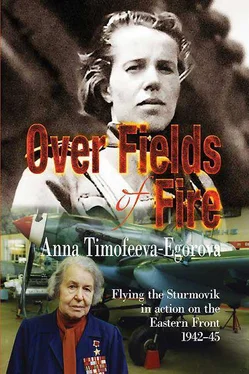Nastya and I went to the graduation ball dressed “to kill” as they said in our village. We wore black skirts made of ‘devil’s skin’ 8 8 Translator’s note — leatherette.
, white calico blouses with sailor collars and white socks and rubber-soled shoes on our feet. We sang, recited poetry and danced at the ball. They entreated me and Nastya — would-be sailors — to dance to Yablochko 9 9 Translator’s note — literally ‘little apple’ — a popular song in the Red Navy.
and we joyfully kicked up our heels with all our might.
Along with our graduation certificates we all received recommendations for further studies. Guryanov and I were recommended for teachers’ college, Nastya Rasskazova for agricultural school. Nikitina, Mila, Lida Rakova were recommended for 9-year school and to continue studying at university.
The papers were calling us to the 5-year-plan construction sites and almost all of our graduating class left for different places. Everyone wanted, as it was said back then, to take part in the ‘industrialisation of the country’. We were eager to work and to study.
That summer my brother Vasiliy spent his vacation in our village. He helped mother mow hay for the cow and stocked firewood for the winter. He told us a lot about Moscow, construction sites, and about the underground railroad — the Metro — which was to be built in Moscow.
“What for?”, mother asked.
“To get to work faster”, Vasya 10 10 Translator’s note — diminutive from ‘Vasiliy’.
answered. “In many developed countries Metros were built even in the middle of last century, in London, New York, Paris…”
We were all were surprised by my brother’s knowledge and most of all by the fact that a Metro would be built in Moscow. This word had not been heard before! I had already decided for myself that I would go with my brother and try to find a job on this mysterious construction. But when I advised mother of this she began to object, and lamented “I’ve brought my kids up and now they all are going to fly away from their native nest and I’ll be left alone”. Vasya convinced mother I would definitely keep studying in Moscow and on that we left.
Upon arrival in the capital the first thing I did was to go and look for a district Comsomol committee. I gingerly entered the building and began to guess which door I should knock on.
“What are you looking for, young lady?” a man dressed in overalls asked me.
“I want to work for Metrostroy 11 11 Translator’s note — abbreviation for Metro Construction.
!”
“Are you a Comsomol member?”
“Yes!”
“Write your application”, the chap suggested, and asked a passing girl: “Where shall we send her?”
“And what can she do?”
“Nothing yet” he answered for me.
“Then send her to the Metrostroy Construction School FZU.” 12 12 Translator’s note — FZU — Factory-Plant School — a common educational establishment for young industrial workers in the USSR in 1930s.
“Alright!”
And right there in the corridor, on the window sill, the man immediately wrote me the school’s address on a piece of paper: 2, Staropetrovskj-Razumovskiy Passage.
And off I went. In the FZU during the entrance examination I was told that the Metrostroy badly needed fitters. I didn’t know what fitting was or what it was for but answered firmly, “Alright, I’ll be a fitter!”
The Metrostroy was a Comsomol construction site and everyone was supposed to choose not the job he wanted but the one for which there was a demand. Three and a half thousand Communists, fifteen thousand Comsomol members in overalls, hard hats and metrokhodkas 13 13 Translator’s note — gumboots.
were the vanguard of this remarkable construction effort. And this would ensure its success: in a short period — three years — the first stage of the underground was ready. The work was hard but no one was disheartened and the girls didn’t want to lag behind the blokes in anything. The doctors didn’t want to let us work underground but we kept getting permission for it anyway.
But so far, I kept studying at the Metrostroy FZU. We had four hours of practical work and four hours of theory daily. The study was not easy: for us new chums, wire-cutters that were a toy for an instructor would become heavy and fall out of our hands when we tried to twist wire or cut it. And it was even harder to understand blueprints! So as to live closer to the FZU I moved to a hostel located nearby. It was a whole township of barracks. There were four large rooms in a barracks with three rows of beds in each and a table in the middle. We did our lessons and drank tea at this big table. There were no breakfasts, lunches or dinners as such for us. You couldn’t get up to much on the 28 roubles we were getting!
In 1928 the ‘Three Prelates’ Church near the Red Gate 14 14 Translator’s note — A historic site in Moscow.
was demolished. The No.21 shaft of the Metrostroy was sunk there and later on in 1934 the entrance hall of the ‘Red Gate’ Metro station was built. It was right there in the shaft precinct that we made the first slabs for the joists of the concrete ‘sleeve’ of the tunnel. All the slabs were lifted onto a gantry, from there loaded into a cage, and let down into the shaft. Back then during the first stage of the Metrostroy only loads were carried down the shaft and pulled up it, whereas the pit workers went up and down using a ladder. I will remember that ladder all my life — a narrow well or ‘pit-shaft’ and inside it an almost vertical ladder with narrow footholds. If someone was climbing up and another one down at the same time it was really hard to pass by each other. We had to take our gloves off for it was hard to hold on to the slippery rungs with them on. The light from our feeble lamps was quickly lost in the thick darkness. And the gumboots of other miners following you would step on your hands as you held the rungs. How afraid I was going down into the shaft for the first time in my life! But the further I got from the surface the warmer I got and the lighter it was, and now we were already at a depth of 40-50 metres. Our reinforcing rods lay to one side and trolleys of earth were coming into the pit one after another and the cager was rolling them into the cage and sending them upwards.
The cager is a pit worker who receives loads and sends them up and down. He’s got a rubber jacket, gumboots and a wide-brimmed hat on and you can’t tell straightaway if he’s a man or a woman. He seems like a giant not only because of his dress but also because he so easily handles the trolleys loaded to the top with earth. But now the cage is gone and I see the cager, having taken off first his hat and then a small cap turned peak-backwards, straighten his bushy white hair…
We, yesterday’s new brigade of pals, shouldered our reinforcing rods and, bent over by the weight, strode forward through a gallery towards the tunnel where they would have to be put together precisely according to the design drafts and every crossover tied with wire. Then carpenters would make a casing and the concrete workers would pour concrete into it… We walked through the gallery in single file. It was hard to walk for the load was heavy and we wanted to throw it down, straighten up and have a rest. But we carried on lugging it and someone began to sing quietly “Through the valleys and across the hills…”
Suddenly I felt a sharp push, a flash as bright as lightning and then, darkness, and in the darkness cries… I had received a heavy electric shock… I came to my senses in the shaft precinct: I was being carried somewhere. Noticing an ambulance I got scared, broke away from the hands carrying me and dashed off onto the piles of gravel…
Читать дальше












